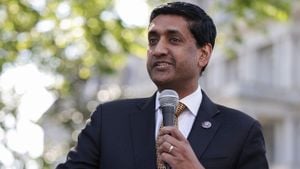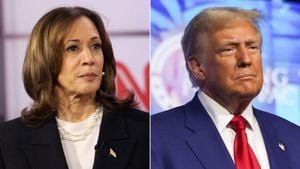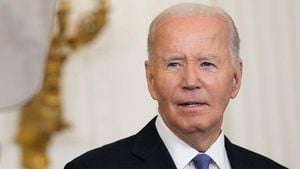With Donald Trump returning to the Oval Office after defeating Kamala Harris, both supporters and opponents are bracing for what his second-term presidency might look like. The anticipation surrounding Trump's policies and their potential consequences is palpable, making it clear many are already debating the impacts even before he officially takes office.
For supporters, the news is largely celebrated. Dale Thomas, president of the Westlake Village Republican Women’s group, described the atmosphere among Trump backers as one of jubilation. She believes Trump’s experience from his first term will enable him to navigate challenges more effectively, making the nation stronger. According to Thomas, many voters are feeling empowered by Trump’s victory, viewing him not just as their choice for president, but as the necessary leader to address governmental inefficiencies.
On the flip side, those opposed to Trump are grappling with feelings of anxiety and frustration. Laura Cook, remembering the powerful protests from Trump’s first term, laments, “I feel like our resistance is less organized this time around.” Eight years ago, Cook and her mother participated together in the Women’s March, standing against what they saw as the rise of a leader contrary to democracy and the rights of marginalized groups. Now, she feels defeated and cautious about the potential for significant backlash against the progress made during the past presidential term.
Activism, once vibrant and widespread, seems to be shifting its tone. Community demonstrations are still planned, including women’s marches across California, but their scale and energy feel diminished compared to previous years. Some like Shane Meserve, president of the Justice for All Ventura County group, characterize the mood as one of resignation rather than determination. He articulated the sentiment succinctly: “There’s nothing we can do about this election. We just have to endure it.”
With respect to policy expectations, experts have expressed concern over the looming possibility of inflation and economic instability under Trump’s leadership. Nouriel Roubini, known as ‘Dr. Doom’ for his pessimistic forecasts, warns of inflation rising to as high as 5% as Trump reinstates tariffs against Mexico, Canada, and China, similar to his previous term. Roubini elaborates, saying, “Unfortunately, many of the other policies are going to have-related high inflation and lower economic growth.” He emphasizes the precariousness of Trump’s trade policies on average consumers, those already grappling with inflated grocery prices and soaring housing expenses.
The optimism from Trump's circle, conversely, hinges on significant promises to lift the economy through tax cuts and deregulation. Baker Hughes economists and other supporters forecast potential economic growth through strategies aimed at boosting jobs and industries adversely affected by former trade artifice. Observers are left to wonder whether short-term success will lead to long-term stability or if it is merely spinning gears on borrowed time.
Beyond economic ripples, Trump's return presents potential shifts surrounding immigration policies, particularly with his plans for mass deportations. Trump critics are quick to point out the adverse societal outcomes this could cause, arguing mass deportations can hamper economic growth by reducing legal wage growth and labor supply. Roubini mentions, "mass deportation is stagflationary,” indicating the dual pressure of rising prices alongside stagnant wage growth may pose significant challenges for working-class Americans.
People directly impacted by these possible policy changes remain particularly worried. Many immigrants, who have found safety under frameworks like DACA, express increased concern about their future. David Gonzalez, who once organized protests against previous attempts to end such programs, shared how he now adjusts to life outside activism: “Life happens. I have to take care of bills and work.” Despite his shift, his fears about potential deportations loom large, emphasizing the real risk faced by those who do not have permanent legal status.
Meanwhile, discussions surrounding Trump’s cabinet selections are also concerning for many citizens. While his administration is preparing to implement its agenda, critics are highlighting appointments like Robert F. Kennedy Jr. as indicative of the administration’s anti-establishment stance. Advocates fear the choices signal not only policy directions but troubling views on public health. These cabinet selections have added to worries about the administration potentially using power to marginalize vulnerable groups.
The Supreme Court is another key area of concern. Having been reconfigured significantly during Trump’s first term, some observers are left to ponder how it will react amid potential new policies. According to experts, it could emerge as the most significant check on Trump’s agenda, particularly if he attempts to assert powers not previously tested.
While there seems to be little doubt as to the political divide, many are left pondering what kind of legacy Trump truly desires. Political commentators suggest he has two paths — one riddled with vengeance where he rehashes battles against those he perceives as enemies, or one of humility where he genuinely considers the well-being of all Americans. The spectrum of responses within communities reflect how those on both sides are challenging themselves with the politics of Trump’s anticipated second term.
Considering Trump's future policies, the question of unity or division rings loud among voters and those affected by his decisions. Activist groups, though weary, are called upon not merely to resist but to advocate for vulnerable communities amid concerns of new laws and potential rollbacks to minority protections.
The more significant results of the election and incoming administration’s priorities remain to be seen, but one thread is certain: communities are bracing themselves for turbulence and uncertainty.
Overall, as Trump's second term looms, it's clear the nation may be heading for another contentious period marked by political turbulence and social division. For his supporters, it could be a refreshing return to governance focused on economic growth, but for his critics, it signals days of advocacy and resistance against policies viewed as potentially harmful to the fabric of society.
Weighing all these factors, as the nation gears up for what’s to come, it seems communities on both sides are preparing for the challenges of the second Trump administration, whatever they might bring.



